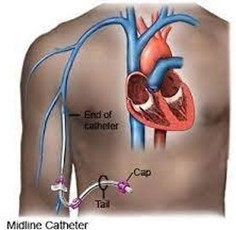A patient on the cardiac floor has just had a PlCC line placed by the MD. the Xray team has not verified the position of the catheter tip, yet. You check the heart monitor and notice she begins having an irregular heart rhythm called Atrial Fibrillation. You anticipate that the PlCC line is touching which chamber of the heart?
Left Ventricle
Right Ventricle
Right Atria
Left Atria
The Correct Answer is C
A PICC line is a long, thin tube that’s inserted through a vein in your arm and passed through to the larger veins near your heart 1. If the PICC line is touching a chamber of the heart, it is most likely touching the right atrium 2.

Nursing Test Bank
Naxlex Comprehensive Predictor Exams
Related Questions
Correct Answer is B
Explanation
Choice A reason: This is incorrect because it shows that the PN is not familiar with the nursing diagnosis criteria. Three defining characteristics are not the least number required for the diagnosis of Impaired Verbal Communication.
Choice B reason: This is correct because it shows that the PN is familiar with the nursing diagnosis criteria. One defining characteristic is the least number required for the diagnosis of Impaired Verbal Communication, according to the NANDA-I taxonomy.
Choice C reason: This is incorrect because it shows that the PN is not familiar with the nursing diagnosis criteria. Four defining characteristics are not the least number required for the diagnosis of Impaired Verbal Communication.
Choice D reason: This is incorrect because it shows that the PN is not familiar with the nursing diagnosis criteria. Two defining characteristics are not the least number required for the diagnosis of Impaired Verbal Communication.
Correct Answer is ["B","C","E"]
Explanation
Explanation: Central venous catheters are catheters that are inserted through a vein in the chest, neck, or groin and then threaded through to a large vein near the heart. These types of catheters are used for long- term treatment and monitoring of critically ill patients.
A midline catheter is a type of peripheral IV catheter that is longer and extends into the upper arm, but it does not reach a central vein and is not considered a central line. Therefore, option a. is incorrect.
A peripheral IV catheter is inserted into a peripheral vein (e.g., hand, arm), and it does not reach a central vein, making it a peripheral line. Therefore, option d. is incorrect.
A tunneled catheter is a type of central venous catheter that is inserted through a small incision in the chest and then tunneled under the skin to a central vein. It is typically used for long-term treatment and is less likely to become infected than a non-tunneled catheter. Therefore, option b. is correct.
A non-tunneled catheter is a type of central venous catheter that is inserted directly into a central vein in the chest, neck, or groin. It is typically used for short-term treatment and is more likely to become infected than a tunneled catheter. Therefore, option c. is correct.
A PICC line (peripherally inserted central catheter) is a type of central venous catheter that is inserted through a vein in the arm and then threaded through to a central vein near the heart. It is typically used for long-term treatment and is less invasive than other types of central lines. Therefore, option e. is correct.

Whether you are a student looking to ace your exams or a practicing nurse seeking to enhance your expertise , our nursing education contents will empower you with the confidence and competence to make a difference in the lives of patients and become a respected leader in the healthcare field.
Visit Naxlex, invest in your future and unlock endless possibilities with our unparalleled nursing education contents today
Report Wrong Answer on the Current Question
Do you disagree with the answer? If yes, what is your expected answer? Explain.
Kindly be descriptive with the issue you are facing.
